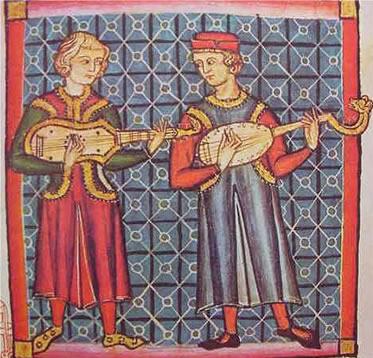Welcome to the midevil page! This page mostly concerns the time period of the 16th century to the late 19th century.
This page will describe the modern shape of the guitar, and where it came from. The ancient page mostly concerns
the early ancestors of the guitar. The midevil ages started to use a more modern guitar like body and neck
as some of the ones today. The picture in the bottom right corner shows this well. That exact picture is
actually the first known drawing of the guitar as we know it today!
The guitar as we know it was probably first played in Spain by the early 16th century.
It derived from the Guitarra Latina, a medieval musical instrument that had a waisted
body and four strings. This guitar, however, was more narrow and had a deeper body than
the modern guitar, as well as a less obvious waist. The guitarra latina had four courses
of strings, including three double strings, with the top one being a single string.
These strings ran along from a pegbox that was similar to one found on a violin all the
way to a tension bridge that was glued onto the soundboard. The bridge helped to keep the
strings pulled tight. On the belly of these original guitars, you would find a circular
soundhole, which was often designed with a beautiful caved, ornate wooden rose. During the
16th century, this guitar would be tuned to C–F–A–D, which was similar to the lute and vihuela,
which was a guitar-shaped instrument played in Spain.
